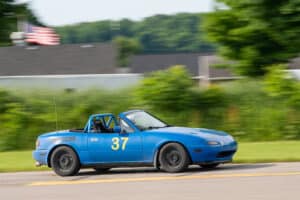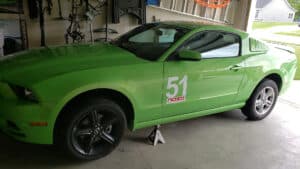
Drive your car on America's most famous road courses!
You have always wanted to know what “she could do”, but you know the streets and highways are not the place. NASA gives you and your car an easy, safe, and affordable way to get on the track! No speed limits, no pedestrians, but best of all-no tickets. The NASA HPDE provide you with a certified instructor to help guide you through the event, one on one, as you learn how to handle your car at the limit. You set your own goals and go as fast as you feel comfortable going.
Basically, all you need is a safe car and a helmet. The car does not have to be fancy or fast. Students bring everything from a Hyundai to a Ferrari. Read the requirements for the other miscellaneous items required.
Anyone who is a member of NASA may participate. Minimum age is 18 (16 with parental consent). Many different types of people enter our events. The number of women who are taking our courses has steadily increased and most are very eager to enhance their driving skills. A lot of husbands and wives also team up and use only one car which makes it a little bit more convenient. There are many teenagers and young adults who receive a school entry compliments of their parents who want to teach their kids to be safer drivers. Note- All passengers must be at least 18 years old. Please see section 4.6 of the Club Codes and Regulations.
Body damage to cars very rarely occurs, however you are encouraged to check with your insurance company regarding coverage. Most standard insurance policies exclude coverage on-track, including HPDE, time trial, autocross, and racing. Double check if they tell you it’s covered. Agents have been wrong before. Ask them for a list of “exclusions” in YOUR policy and consult an expert.
With HPDE and Time Trial insurance through Hagerty, you can keep your focus where it belongs – the drive. Let us protect your car with our affordable HPDE insurance program*, offering coverage for your vehicle while it’s on the track, unlike your standard insurance plan.
What we protect:
* Track day policies underwritten by RLI. Hagerty determines final risk acceptance. Some coverage not available in all states. This is a general description of coverage. All coverage is subject to policy provisions, exclusions and endorsements.
Now that you have signed up for the HPDE, you need to...
What is weight transfer? A car, at rest, distributes its weight over...
Some people believe that an occasional spin or crash is essential to...
Many drivers believe that the key to driving quickly is to drive...
The line is the path around the track, that when driven at...
Learn the essential rules of passing during HPDE events to ensure safety...
After much prodding from my friends I finally committed to going to...
UpshiftingUpshifting should be done smoothly. Speedshifting will shorten the gearbox life. The...
Whether your goal is to run HPDE or to be the next...
HPDE Resources
Questions and Answers to Feed Your Curiosity
Convertibles with proper rollover protection — whether it’s from the factory or aftermarket — are eligible to participate in HPDE. You can find a list of acceptable factory and aftermarket systems here.
Special insurance is not required but certainly recommended. NASA recommends purchasing affordable HPDE and Time Trial insurance coverage through Hagerty for your vehicles during the event.
Take advantage of Hagerty’s Track Day Insurance coverage so you can focus on what matters: the drive.
What we protect:
Latest HPDE News Around The Country
Factory camber adjustability on the 2024 Ford Mustang can be insufficient once your car is lowered, leading to poor handling and premature tire wear. […]
After mulling it over for some time, I decided to buy a Honda Fit for my new daily driver. I’d also thought about the E46 330i, which met most of […]
After tracking a short list of Toyotas — an MR2, Lexus IS-F, and a GR86 came first — Marshal Moore decided on turning his teenage fantasy machine […]
It is always nice to have a little bit quicker car in front of you, whether it is HPDE, racing or Time Trial. In this week’s installment of the […]
As NASA’s official tire retailer, TrackDayTire.com gives NASA members immediate access to an extensive national inventory of Toyo and Hoosier DOT R […]
What HPDE Drivers Say



Getting Started in HPDE